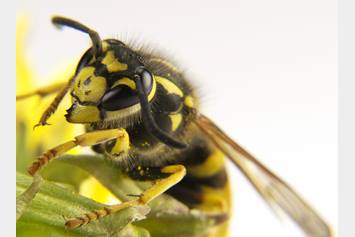Hives
Hives, also called urticaria, are red, itchy, raised bumps or welts on the skin. Hives are the body's response to an irritation. The cause (trigger) may be non-allergic or allergic.
What Are Hives?
Hives are red, raised bumps on the skin that can be itchy. Hives are also called urticaria. About 1 in 5 people will get hives at some point in their lives.What Are the Signs and Symptoms of Hives?
Hives can be found anywhere on the body. They can be small, like mosquito bites, or several inches wide. Even if they look different, hives often have common symptoms.
- People may have one hive or groups of hives that cover large areas of the body.
- Hives can move around on the body. They may start in one place, then move to another place on the body.
- Hives may go away quickly or come and go for many weeks or months.
- Skin swelling is common with hives. It may happen on the lips, ears, eyelids, fingers, or toes. This is common and not dangerous.
- Less commonly, hives can occur as part of a more severe allergic reaction called anaphylaxis. Anaphylaxis can cause the airway to swell, making it hard to breathe. This is a life-threatening reaction that needs to be treated right away.
What Causes Hives?
Hives happen when the body releases a chemical called histamine. It can be released because of allergies or other things, like stress, infections, or some illnesses. Whatever is causing histamine to be released is called a trigger.
- Hives not related to allergies are more common. Their triggers are:
- Viruses or infections, like a cold, strep throat, or a urinary tract infection (UTI).
- Emotional stress, like anxiety, anger, fear, or sadness.
- Exercises that make the body warm.
- Vibrations from using a lawn mower, horseback riding, or mountain biking.
- Temperatures that are too hot or too cold.
- Sunlight or tanning beds (sunlamps).
- Pressure on the skin, like being rubbed too hard or scratched, or by wearing clothes that are too tight.
Hives that are related to allergies are less common. Their triggers are:
- Foods or medicines (anaphylaxis may occur) – Symptoms include nausea, throwing up (vomiting), mouth/throat swelling, and trouble breathing. This can be very dangerous.
- Some common foods that cause allergies include eggs, peanuts, tree nuts, milk, and shellfish.
- Some medicines that cause allergies include aspirin, ibuprofen (Advil®, Motrin®), and naproxen sodium (Aleve®).
- Contact with the skin that can lead to irritation. These are usually not dangerous.
- Plants, grasses, weeds
- Acidic foods or sauces
- Scents or fragrances (soaps, detergents, lotions)
- Animal dander
- Latex or other materials
When to Get Emergency Help
Call 911 or take your child to the closest emergency room if they have hives and any symptoms of anaphylaxis:
- Trouble breathing, swallowing, or talking
- Swelling of the mouth or tongue
- Nausea or vomiting
If they have an epinephrine auto-injector, like EpiPen®, Auvi-Q®, or Adrenaclick®, use it right away.
How Are Hives Treated?
Treatment depends on how bad the itching is. Even with treatment, hives can last days to weeks. The goals of treatment are to:
- Control the itching
- Avoid things that may trigger hives
For mild hives:
- Give an over-the-counter (OTC) antihistamine each day. Some examples are:
- Loratadine (Claritin®)
- Fexofenadine (Allegra®)
- Cetirizine (Zyrtec®)
- Levocetirizine (Xyzal®)
- Do not use Benadryl® creams. These may cause irritating rashes.
- Cool the skin using an ice pack or a cold bath or shower.
- Distract your child by playing games, singing songs, or reading books.
- Avoid known triggers, like animal dander or fragrance.
For severe hives:
- Give a higher dose of antihistamines or steroids, like prednisone. Oral steroids should not be used a lot. They may make hives worse when you stop taking the medicine.
- See a doctor or health care provider. They may prescribe a medicine, like Xolair® shots (injections), if you have long-term (chronic) hives.
Living With Hives
Living with hives isn’t easy, especially if you don’t know what’s causing them. It may help if you write down events that happened right before the hives appeared. This can help you and your child make a plan to keep the hives from coming back.
Depending on what’s causing your child’s hives, you can keep their hives from getting worse by having them:
- Avoid scratching or rubbing their skin.
- Wash their hands after touching pets or animals.
- Wear loose-fitting clothes.
- Wear warm clothes.
- Wear sunblock and long sleeves and pants in the sun.
- Avoid contact with cold water if they’re sensitive to cold.
- Use mild, unscented soap on their skin and for washing clothes.
When to Call the Doctor
Call the doctor or health care provider if your child’s hives get worse or prescribed medicine isn’t helping.
Helping Hands Patient Education Materials
Written and illustrated by medical, nursing and allied health professionals at Nationwide Children's Hospital, Helping Hand instructions are intended as a supplement to verbal instructions provided by a medical professional. The information is periodically reviewed and revised to reflect our current practice. However, Nationwide Children's Hospital is not responsible for any consequences resulting from the use or misuse of the information in the Helping Hands.
HH-I-82 | ©1989, revised 2023, Nationwide Children’s Hospital



